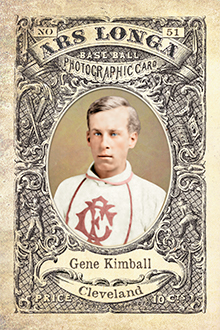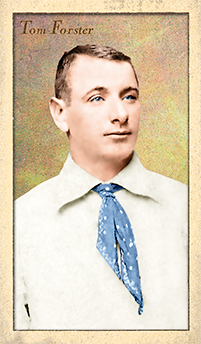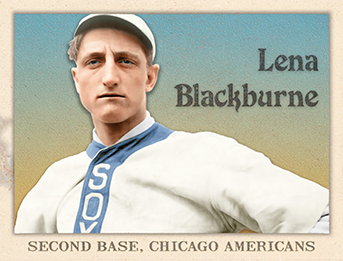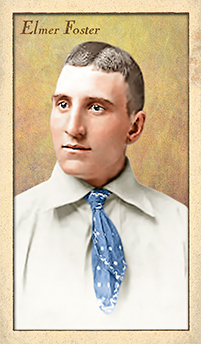
- Series: Pioneer Portraits I: 1850-1874
- City: Cleveland
- Team: Forest Citys (NAPBBP)
- League: National Association (NAPBBP)
Eugene Boynton Kimball (1850-1882) was an evanescent spirit on the early baseball scene. This ghost came to the (Cleveland) Forest Citys on May 4, 1871 and departed what was then major league play the following September. He had played in the early amateur National Association of Base Ball Players for the Alert of Rochester in 1869 and for the Cleveland club in 1870. That team was the first fully salaried team in Cleveland and was unaffiliated that season. In 1870 the Forest Citys (a designation adopted in recent years to distinguish the team from the pro club in Rockford, IL known as “Forest City”) were managed by Charlie Pabor. Charlie was dubbed “The Old Woman in the Red Cap,” giving him enduring status as the baseball figure with the most mysterious and alluring nickname of all time.
- Kimball’s debut in Rochester occurred on June 4, 1869 when the Alert hosted the powerhouse Cincinnati Red Stockings on their famed national tour. Gene played alongside other future major leaguers: John Glenn, Sam Jackson, John McKelvey and Ezra Sutton. The young amateurs held Harry Wright’s bombers to one of the closest margins of that undefeated season
- In his brief time with Cleveland, Gene managed a .191 average. He made 44 errors in 170 chances playing 2nd, 3rd, short and outfield in 29 games. It is reported that he achieved fair renown as a billiards player following his baseball career

- Series: 1880s: Spotted Ties
- City: New York
- Team: Metropolitans
- League: American Association
Thomas W. Forster (1859-1946) played infield and outfield for three teams in the 1880s. His major league tenure began with the Detroit Wolverines of the National League in 1882. Tom had begun in pro ball the year before with three teams in the Eastern Championship Association: the New York Qucksteps, the New York New Yorks and the Washington Nationals, who also represented Albany, NY in '81. Following Tom's rookie season he went out to Michigan and played for the East Saginaw club in the Northwestern League. He began there again in 1884 before getting hired by the Pittsburgh Alleghenys. He got into 35 games for the team that would finish 11th in the American Association. Before the season was out, Tom was shipped back to NY and the Metropolitans. He got into only one game in '84 but saw action the next two years. Unfortunately, Forster couldn't hit in the big leagues. He was .221 in '85 and .195 in '86 with minor league stints interspersed. He ended up out “west” with Milwaukee and Davenport before returning east for final campaigns with the Hartford, CT entry in the Atlantic Association. Tom was player-manager at the end of the 1890 season.
- Forster's batting average over his four MLB seasons was .197. He had his sole HR with the Metropolitans in 1886
Auction History
Cartophilia
Old Judge Pose: 167-1
- Series: 1880s: Spotted Ties
- City: New York
- Team: Metropolitans
- League: American Association
Elmer Ellsworth Foster (1861-1946) was primarily an outfielder with the New York Metropolitans, New York Giants and Chicago Colts over a six year span beginning in 1886. The very rare baseballer who threw left and batted right, Foster achieved a career batting average of .187.
- One of the first five major leaguers born in Minnesota
- Played at Haverhill with future Hall of Famers Wilbert Robinson and Tommy McCarthy
- Noted for his speed on the base paths, Foster always had an explanation if caught stealing: “Why, I wasn’t a bit tired. Why should I have stopped running?”
Auction History
Cartophilia
Old Judge Pose: 168-1

- Series: Diamond Heads '15
- City: Chicago
- Team: White Sox
- League: American League
Russell Aubrey Blackburne (1886-1968) was no great shakes as a player and had a sub-.500 career as a manager. Not many with a lifetime .214 average get mentioned at Cooperstown. But Lena had a bulldog spirit and a zeal to improve one key aspect of baseball: the sheen on the balls themselves. Until Blackburne’s “Rubbing Mud,” balls were doctored with tobacco juice, Shinola, and whatever the local swamps provided, all in an attempt to take some of the manufacturer’s shine off the spheres. Lena found a solution that still serves the game today. True to his discoverer’s spirit, he kept secret the source of the clay from which he made the rubbing compound. It was believed to be a spot on the Delaware River near his home. Blackburne had played for the White Sox, Reds, Braves, and Phillies before coaching and managing for the Sox, Browns and Athletics. He was enough of an AL-partisan to restrict use of his wonder-mud to the American League until the mid-1950s when the NL at last could partake.
- No other compound improved the grip on the ball without damage to the horsehide
- No one has gotten rich from the Mud. Team’s can get by with one 32-oz container per season at a cost of about $60. The current vendor of Blackburne’s concoction has to work full-time to support his family

- Series: Beginnings: 1870's
- City: Boston
- Team: Red Stockings (NAPBBP)
- League: National Association (NAPBBP)
Thomas Lamb Beals (1850-1915) played for four early major league teams, getting into 123 games in six seasons over the first decade of big league ball. He began in Washington D.C. with the Olympics of the NABBP in 1871. He batted .194 in 10 games, which was about a third of the schedule.. He came back the following year and hit .306 playing in all nine games. His manager with the Olympics was Nick Young, one of the founders of the game. He followed Young to the new D.C. club, the Blue Stockings, in ‘73. Beals was a regular that year and hit a respectable .276. He had played under the name W. Thomas in Washington. When he moved to the powerful Boston Red Stockings in 1874 he assumed his given name. He was only a part-timer in Boston for two seasons. When the National Association gave way to the new National League in ‘76 Tommy found himself out of work. He got one more chance with the White Stockings in 1880, getting into 13 games. His poor .152 average sent him into retirement.
- During his hiatus from the majors Beals had played briefly in the Bay Area for the SF Mutuals and the Oakland Pioneers in the California League




